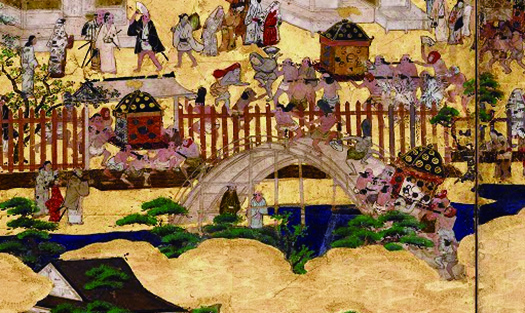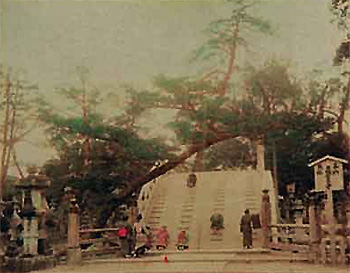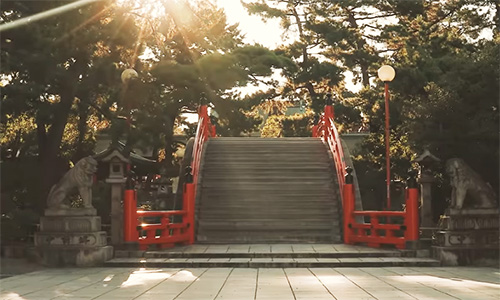


屏風絵という表現形式は中国からもたらされたものだけれど、
中世になると日本産の金屏風絵が遣明船などでの贈答品として3品、
必ずリストに挙げられていたということで、日本の特産品化していたようです。
画題の中では「洛中洛外図」のように都市風景がポピュラー。
都市風景には当然、庶民を含めたにぎわい、日常生活が主題化する。
そういった画面から極彩色の空気感やリアリティが浮かび上がってくる。
堺の都市風景をテーマにしてみたのですが、
この堺市博物館所蔵の「住吉大社祭礼図」を見ていると
文化風俗のすべてが湧き上がってくるような気分が立ち上ってくる。
堺の頓宮に向けていま、住吉大社を神さまの神輿が出発する様子。
住吉さんと言えば「反橋」ですが、神輿はこの橋を渡るのですね。
合計4柱の神輿が渡るのですがいま最初の神輿が渡り、
2番目、3番目の神輿がいまや遅しと渡御を待ち構えている。
神輿周辺には身振りで景気づけする人々が描かれている。
担ぐ人たちもほぼパンツ一丁の半裸姿で描かれている。
現代でもこの住吉祭は7月末〜8月アタマなのでさぞ暑かったのでしょう。
橋を渡るのがひとつのクライマックスのようで、神輿の後ろで
踊り狂っているような人々もいる。
2枚目の写真は明治初年の反橋を西洋人が撮影したもの。
日本社会ではこういった神さま、神輿といったバーチャルな尊貴性が
文化の底流に根深く存在していると思う。
たしかに個人や開拓神への崇拝に出自はあるのだろうけれど、
ナマな属性は消去されてシンボル性だけが表出して
民衆性が表面を覆いつくしてしまっているかのように思える。
そういう文化の民衆性から表現もマンガ的な形式が採用されることが多い。
この屏風絵などにもその傾向が顕著だけれど、
鳥獣戯画のように日本の神性はキッチュさをまとうことが多い。
日本人の民俗性の根底にこうした普遍性、わかりやすさがあるのだと思う。
いまやマンガは世界に冠たる日本文化の粋。
マンガという表現形式については国境を越える普遍性があると思える。
その機縁・象徴として神社文化というのは面白い民俗性を持っている。
欧米文化がキリスト教をベースに「民主主義と科学」で現代を規定しているのに対し
民俗性としての神社習俗、その大衆性という側面を
日本独特の文化交流戦略として構築するのもありかも。
神事からスタートした相撲が文化として世界に受容されてもいる。
まぁ不思議の国ニッポン路線だけれど、ユーモアは国境を越えられる。
民俗に根ざした文化は民主主義と科学とも予定調和できる部分がある。
おっと、江戸期の大衆文化から飛びすぎかなぁ・・・。
English version⬇
[Sumiyoshi Taisha Shrine Departure / Japanese Good House Special Edition ㊱-3]
The expression form of folding screen painting came from China,
In the Middle Ages, three Japanese gold folding screen paintings were given as gifts on the ship.
It seems that it was a Japanese specialty because it was always on the list.
In the subject, the cityscape is popular like “Rakuchu Rakugaizu”.
Naturally, the urban landscape is lively, including the common people, and everyday life is the subject.
From such a screen, a vividly colored atmosphere and reality emerge.
I tried the theme of Sakai’s urban landscape,
Looking at the “Sumiyoshi Taisha Festival Map” in the Sakai City Museum
I feel like all the culture and customs are springing up.
A mikoshi of the gods departs from Sumiyoshi Taisha toward Sakai’s Tongu.
Sumiyoshi-san is called “Arched Bridge”, but the portable shrine crosses this bridge.
A total of 4 pillars of portable shrines are crossed, but now the first portable shrine is crossed,
The second and third portable shrines are now waiting for the transfer.
Around the portable shrine, people are depicted who are gesturing.
The people who carry them are also depicted in half-naked figures with almost one pair of pants.
Even today, this Sumiyoshi Festival is from the end of July to August, so it must have been hot.
Crossing the bridge is like a climax, behind the portable shrine
Some people seem to be crazy.
The second photo was taken by a Westerner of the arched bridge in the first year of the Meiji era.
In Japanese society, virtual nobility such as these gods and portable shrines
I think it is deeply rooted in the undercurrent of culture.
It is true that they have their origins in worshiping individuals and pioneer gods,
Raw attributes are erased and only symbolism is revealed
It seems as if the popularness has covered the surface.
Due to the popularity of such culture, manga-like forms are often adopted for expressions.
The tendency is remarkable in this folding screen picture, but
Like Choju-Giga, Japanese divinity often wears kitsch.
I think that such universality and comprehensibility are the basis of Japanese folklore.
Manga is now the essence of Japanese culture that is crowned in the world.
It seems that the expression form of manga has universality that transcends national borders.
The shrine culture has an interesting folklore as its connection and symbol.
Whereas Western culture defines the present age with “democracy and science” based on Christianity
The aspect of shrine customs as folklore and its popularity
It may be built as a cultural exchange strategy unique to Japan.
Sumo, which started from Shinto ritual, is also accepted by the world as a culture.
Well, it’s a wonderland Nippon route, but humor can cross national borders.
A culture rooted in folklore has a part that can be planned and harmonized with democracy and science.
Oops, I wonder if it’s too far from popular culture in the Edo period.
Posted on 7月 7th, 2021 by 三木 奎吾
Filed under: 住宅マーケティング, 日本社会・文化研究







コメントを投稿
「※誹謗中傷や、悪意のある書き込み、営利目的などのコメントを防ぐために、投稿された全てのコメントは一時的に保留されますのでご了承ください。」
You must be logged in to post a comment.